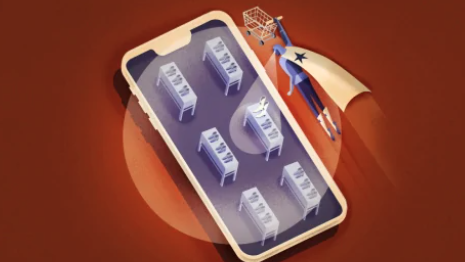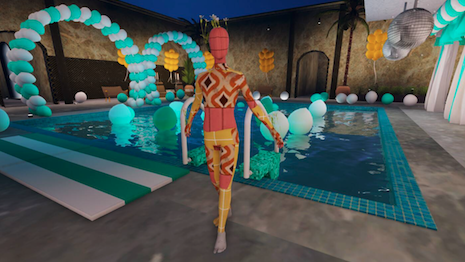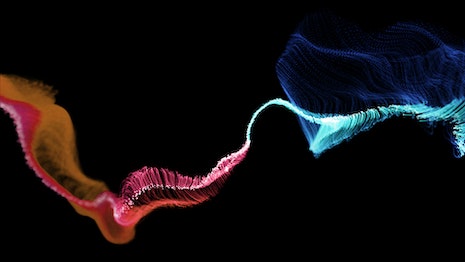The metaverse may prove a haven for prosperous financial opportunity, according to a recent report from banking giant J.P. Morgan.
The “Opportunities in the metaverse” report highlights how brands, retailers and public figures are getting started in the metaverse, with this virtual network growing globally each day with expectations to infiltrate every sector. With $54 billion spent on virtual goods every year, brands are being called to learn and assess the metaverse and create meaningful spaces to connect with consumers.
"For luxury brand customers, the metaverse should provide an experience that is not available in the real world," said Zach Hungate, head of gaming at metaverse investment company Everyrealm, New York. "Why would someone come to the metaverse when they could do the same thing in real life — and probably have more fun doing it?
"The most successful metaverse activations have defied traditional aesthetics and architecture, as we've seen," he said. "Because gravity does not exist in the metaverse, your digital goods store could, for example, be floating above the ground."
Everyrealm assisted in creating J.P. Morgan's lounge in Decentraland's Metajuku shopping district.
A whole new world
The metaverse is a network of virtual worlds, consisting of certain technologies, aiming to foster social connection. It melds characteristics from the current phase of the Internet, with characteristics from Web3 the next phase of the internet.
Contemporary characteristics inherent in the metaverse include mobile-first approaches, social platforms and user-generated content, while Web3 characteristics that drive the metaverse include artificial intelligence, decentralization and cryptocurrency.
 AR is a popular feature in the metaverse. Image credit: Deloitte
AR is a popular feature in the metaverse. Image credit: Deloitte
As J.P. Morgan anticipates that the metaverse will pervade every sector, the market opportunity is estimated at more than $1 trillion in yearly revenues.
The bank has already recognized the opportunities inherent in several metaverse features, including cryptocurrency, having been the first major U.S. financial institution to launch its own cryptocurrency (see story).
Succinctly, there is a mammoth opportunity here for brands to make money through the metaverse by offering physical and social concepts to consumers through a digital lens.
Luxury brands and retailers continue to flock to the metaverse as new technologies come together to make the virtual network better and more enthralling. These technologies include augmented reality (AR), virtual reality (VR), digital currencies and NFTs.
Last year, Italian fashion house Gucci partnered with online gaming platform Roblox for an interactive virtual exhibit celebrating Gucci Garden Archetypes. Approximately 60 billion messages are sent daily on Roblox, indicative how how consumers are eager to express themselves and socialize through digital avatars.
The virtual Gucci Garden space replicated the physical, multimedia experience that debuted in 2021 in Florence. Users were invited to explore the immersive space through avatars as well as purchase exclusive, limited-edition avatar items (see story).
 A Roblox avatar exploring the digitized Gucci Gardens Archetypes exhibit. Image credit: Gucci/Roblox
A Roblox avatar exploring the digitized Gucci Gardens Archetypes exhibit. Image credit: Gucci/Roblox
In February, LVMH Moët Hennessy Louis Vuitton Japan KK partnered with Japanese conglomerate SoftBank Corp. to develop and accelerate new omnichannel customer experiences. Priorities for the partnership include harnessing virtual reality and 5G technology to offer more immersive, real-time experiences for in-store shoppers – all while reflecting LVMH’s tradition of creativity and quality (see story).
Consumers are also able to own products, art and spaces within the metaverse.
Virtual real estate is a growing market, as Ethereum-based platforms like Decentraland sell virtual plots that consumers can develop. In June 2021, Decentraland sold one land package for $913,00, which developer Everyrealm turned into a shopping district called Metajuku, inspired by Japan’s Harajuku shopping district.
The average price of a parcel of land doubled in six months in 2021, growing from $6,000 in June to $12,000 by December across the four main Web3 metaverses: Decentraland, Somnium Space, Cryptovoxels and The Sandbox.
Online video game Fortnite recently held a major concert which was seen by 45 million people and grossed about $20 million. Disc jockeys, party planners and more could flock to the metaverse for these kinds of paying opportunities.
Public figures continue working within the metaverse as well, collaborating with brands in attaching their faces and personas to advertising material. Online gaming has ample space for advertising, as in-game ad spending is set to reach $18.4 billion by 2027.
Luxury NFTs abundant
Non-fungible tokens (NFTs) are another key feature of Web3, and luxury brands are experimenting with these digital assets. NFTs currently have a market cap of $41 billion.
Italian automaker Lamborghini recently announced it is auctioning its last produced Aventador Coupé as an exclusive NFT in collaboration with musical artist Steve Aoki, digital artist Krista Kim and Invnt Group (see story).
Last month, French beauty brand Guerlain supported conservation efforts with the commissioning of its first NFT project. As an ode to the year of its founding, Guerlain commissioned 1,828 unique NFTs in the form of “cryptobees” (see story).
Although the metaverse can be overwhelming in its vastness, there appears to be room for everyone and every brand, with a race to the top imminent.
"We're seeing a trend in the metaverse where aesthetics are becoming more important than brand," Mr. Hungate said.
"It's clear that luxury has a place in the metaverse, given the enthusiasm with which consumers have embraced NFTs and virtual spaces," he said. "But it's even clearer that digital users are drawn to high-quality, artistic products."
{"ct":"BNsFqczgQHOvE\/poM0ZVU+kyaAajpaQV3x3nn5T2mB6lxNOo837vE16xvmoZvhtFWU\/\/di4JyErjp+5n1WMjF\/wetuQUBejJ822BxZPlhFkcY72UXnXsqdUlWHsuqaBUTElm1TZnLVsS5Y01DwIknofMCZom5\/3hupD3unh1Oqcd79u1V1e63\/RFFcJmfUIxLwk+Ykuk5RSTV0KMpEYmsxHaLPj2J9h+eXhfbt5NyfjKZOpGwxNj+3ewFoZgOa+b+qdZKoCtsJZbQJlLWnROQcfk\/HLKZkfXcjYic+o709Wazdq4tDL9hJA0pI5jqfv7f+VOSwJGa8ukwlyvVi7qu3zboeP60X8UFxj8KN5O8bqoz4uVVZjtKWs\/z8BnUlMPApxP5SOVT16AnFE8BEW2HssrtztnZCrDyLW8e9g\/n9BulqF8z2I4Q3cBd23wVIpHFcWMQFPvHDSva4\/OyhrJE2PIKVlXchYmFInxqFJ051Y9VPBrqxieANpXlEcFQs\/W\/KdhjaRMRG7jJwaOI4lTLt7WiqwnAmCPWxFi0pHfSw5fmnWRBEQbVB\/le\/eNzmvb3tf2b+P0CYgupVuy0KAb\/0wc2o2xfZhI\/WUdH70GVH6DFN4KSvYLeh92MTAUrPYiDDUy4pLNg5E\/zmnuBK1h+YFnCSfjytGRcrbbMKIJ3s+U0WrjrIdknbLDLKB0A+wURVbS6savPjypf+ve7fzFtoDJGvGt4H\/fJLaarTlIIkjsyS53wM1KnYE4sMZliFNSxnoJRQHnkY\/IdcCWBWhqolIbYjt6TApXRgFPRbm8YiLPYCrYeOknzFfCoZ2CedJ2a+2HGvdK3Fr+gofEAHTuT5JHzwLZx6dDnfhjPcLo+YQXcr7HCGdSRDaYrgeTxBoijNjoI84Xg+kgoJpMu5io6WgXbp51zAv1yrDEiU23DgqSG9CDDgLVFYLY6Gq9Ar\/cfV3YsDD5JP5YZRXgXOulPj8zNy5nDK11MZTNTfHSCQn2wuLRpwoQyB+x38F40tXgV7JLz0MyWurlSrkH3\/8RU1t+x52sEvVBNXDzZPaLI65p4l8MGQVmnHAYsRk3Av8YfLPgPrKc1d2T\/JlW81XSRPLOcYS5+HNqt+4Qzu+yLhxpAn3ElqQcAxSFoc5dUGQBBfNDAltzkxyqthTd85rQMUaoSvBSfGnyubg6vvRfTvFzgNd1NPcks\/Puig9npmstWJimDui11I+UM1Qo2yyE9Zzt7BaiTYNo4\/Ebn+MZreByJutiPF42vDWIKz\/P31eSPs7EbP3xJrMP4ElPiuPIAZByCS1wca1FK3jiqBPMCZfFpqtBfoSnbu+uo4njGClMzTDSwV6JEw8dzCMu3nO45qQB\/\/T7tpMjV9\/0JUwbO8UpkEo+ztpQ0\/tiyQbmY6NrcZ2BKdLgOXEHTu\/Qf1kTb+IAggBF62pu\/HGaf2WvV2z6twmr3JX0sN+mh8RDbo0vAqKp0G\/hv55PT4DOvWBLZj4Lc+FSjNOgj6GXbVgjqK9WZ9FvvGQHzwOO9zMXoQqydk3uW0Pqr76UTqKVa+9PX56U0ayYQjSBT79E4AqEhDCDVT2Et9leyV3RB6zQEI\/dZJxIb9KSvq1eFjDseUCdBepUd17PB1za\/LnVfn1yS1fpzgU4wxRaERaxpy33G9hVAHES5eims0zCjdDRZQ5zpY\/XjA3l9eNfT\/gItD3Ra8Alo8lDlxm0FU+8obKSxSlppKJjwtcfw9AZuwf4GzueV\/cV+av44PVs0\/Ipe6UFxIhP8hzMsS3ETZnA\/LD1hJTYh94Bwl2xFVbCp1obM2MP1Jg3l9gf3idJeZlopiIppf26UYK9ohoQASomc5aGw4D8+5FDuoRAxj94HzA7mb4vaRQOuoUFyQ7b3Xx94UjYoUQvwZ6iO2iQUdyIj6qw8vi3G\/Sp\/m4pRFiSBP0xE6S\/471SZmoE4ZlV5jS0YG8lYhnKutziIRn+fu8HJUwQjzLPQIOgXw\/G4jDtdk+9rRJvw8nSqausuqsm\/\/hNXJILJqI41p8f24sZdIIHZ\/6HXVkLrUKWTHDCOoaa4jDjfpRbR4nwzBtkDdOWCv9L5F9s1Q+25CEcnGnhs98IsaoyvpZ87bMnByLyhpqCVEEVMfyM3GJd\/+ozw2T3JdgyvgH5MP3EZX78p3gX+PxReMcXpS3yeatoG1gxsw6OhMsShY4KJJIYQo5cHUv6Ldauhjt\/fGkURRLmtS\/mNmna6DYWBxclRDXotj4mJaKU\/S23r0gO1uL2nFaJuDAM\/3NymeTSJ6lhRJoQoL+vutcPAJWNnNWDuFP9YeE+dnOndw2cgBUnaq9jzTaHCtiTLXdifoHy7zQ3Py1+xikN8lsYzFDjtDXkcAWNaJGx06dJzXJy174Ln7BWrQDCt6fZv3sGBQGQW2JEbvzJBFXt9iWdyxNrRIi144lsay1QAWfzEmIkLMOIZUDPfBxmM7hpll2X3+HE+1XN5zTu1bKW+OAn3bI0GsKXKGZBawalpcY1n1aYcf5U9yeCjKfMDgcK0JZ\/18c+6+BEyTkAh3piEgPhbE75xEHYqmcG21VFh5EsB+A0j1mitWO0tJdTOrYQzqb\/eYo7qfhRoXQ9pPXVmBTVehI8A5WcJlCA\/jGezyiaipB+RXdzL1SOa0xTbd9qH7F6xX\/yIFB7Papiuc+oXCXLiEBErjh+scNAQU+HUsFo\/ZnfPXV5\/NmVrQ8XkbxCfIOL6maZKIUMvRBVVP8gwR4stOEXQpcvLnvbfWdnLmujgvL0lzoeVNR8LdTCkBcPbnu6e76xmde0kiy89p01ij+ZN6LSjTo0NAbJyMwoiqy4CugTVe74XY9\/s7rJ2VEdeQZuDIMNsnIr8LiUWGJjWn\/luLhEOtiIxO2NdxLT2QuJpJW6YkpI8OHOvbf8gYtLwZjMtUIfewLezthgWbp0k\/+5ylOMRH5TIQ+PlZL0lWL4MLjHXNdfmJI3mLU7+Hvd\/JWkGl+nPWTk3PWB7os15itIm77WYUA70kR29L9g+rXza1I+af8EJ1bsMtVd1bY+X209L+Gbc+RH2h6GEnt0apmy50DRVQErjzj\/KwTvSPIcxJn\/FbOZm07eMoBRhRvx2G4b4mgVDwSbvfBqRIrBJ0LRPRZGbx74ry8Zv0GP6LGIyFWG9bvZrjfE9FdyHCqyyC6v5zZBKUIoKFZ4YrVQ\/aNmmPUjEWPgftUWkOK4v\/RgeYxsNA6tsiB45BXVXt14W0RogKOOMEaLs51XXtkO9VgVxMcD0mTlP1K7NuY2UdSJlcS3r43R8hZ0XUfrkaOPhPRiqMKz5Xok5ajkQH4RxYOEIwCZYhd2gjbNm7lzSXgb687e46cl1piBrsf7ZR\/fBUeDaQu6rIeTngxxS2ST1EqKCIkosOsKq\/V7\/+SerK5QDfXPFaGqPVy8riSKExqxUu22oivEco+QomGgr\/l76fiHnj6L4Etm0fcgUvqk3rOZ\/FEPWjlsoNm392Gdmvfi1SJsuDV8X\/lF613Lm9nQEnRZkBaKUwDf1AdwV6bC\/BVUksjUPW2pYWUht3bNXzPl7kzLEeDn1E+JTvuT312UWHowT3+q37WUeE78xUVn3Dnr\/zsl8e8SlNAGsIIii7QZCtNMvcjdCJEYlTGRuPtOP4Tuxy3s6vZZpDPz8Q3D+DQVVs5a\/cDlV9\/x9DFmNkyNQtMz7pIOjzkWWkjwlv4ZylApADDGasPBpH5DvsgjlZ2Dyj2ixibKNQxeyhEAuUtpLEiwkVKwBRVkD0oSMUUHUvcOLTEYKOzAAq+qjIq10\/wF9+Kt\/tyKiteHuOKHmoR+Qb3T5n7dompizi9cHipA9JgMyNrkKkVZFMkUPQ7vavoVMkXs3YM4CjB+GBVRjv7VfC2qQDx6bwxRMBaVmeQhSCTdbx9Y0D\/ONVskqXuZdt9Iymu\/Py4VqcL+8SjWHmxDPJ30r0lzuYyyKq8rKXoUlNrIlDweHQVT6odbuoJWO6BBWy1SOEaJmCxC57eYiOcF0EN48Uk4TiKiptIGsige\/AgbJiO0iAj8nyErWTSr5R\/4jYv45KyjSUokDyLeUMyCczY00kfRPA2OYN5VKx+0T2Eeh88CbDQSD7qXyL6ngPgco8V0p3diqOgtDd21Lmgkj22Vbl9CddY0CxXx0\/M+TybLyQiiFOD6ZxossJjHuDGXTlmNchkvw6ugiEGIiC41ldw99uTlUhs1YsudOm3ZKzQijIXrIldf2HONiirP3UH6QZudCjb6pYHd5XU\/DL2k9RadtKZP9it80L6zn6qG+Y6xN8YqmX4NvK82LiSh2rGKrOYKj3Js9t80TmSiv9pLVDewS4olCDoH12sJmJw0PtLWbmTeGM++QpxlcGkreEnWOpvWaIiXhM8r0g7+ECzfjMQ1iwnY7dh9uWScGkeXooLougyvjUvxs5ALPPbKf3iMRmid6q1AyhSqFd4wEiwdhcjj4x5mjI2\/hFvf86kOWvkI2fQM33k7ynJBXjwT+cNBkZvBiLUCSDjaW4TN06mcWtkzwwDriUwzsX20ejVgqFhdNrqcaqfOvX9GLOoF4Ku6OrkziHbHz3GIXdYnq4zfJhqKkD\/0UXP2MDGzZQPswo3hcX5Ilpn4qSpQwTn60RZh9Qy0tVsGzF2GdrwI4xtOq7x8tBX7KyvhtlqYvioMrzQX8t6yNcTsFTa6O5KodnATiBgMs4Ssr8DYFovIZZ+R\/hCxBlsQ9gtCvxjXK6zxAgIeC8I3fGhwMxykTBfTX\/vVY+Hw7F0z8cT6V5gwuUFrb5BB1+pWhcwj5u+f1LTsNV3uAJiw2CF0fFOCUTiaCclQFWfozSeAE\/OTHrDzqV2CPGv7f6O2AQo5yVrxNURkSHeeCCzB\/7oLyz0Bc3g7QnW1i7Og3JdEIsud78AKhTq70sSYlwYHYO2fDnvAjdn5KmjG051htQoPHP0ug0U0g6zSq6WHIaVdYw6WxjsqEgaKh+swOsYhHNaHbU5dQNQQjCo\/2aoWhUETSoDm7GMHYog4wQMy8vuHdYrZJ2QopnR7U4a43y4iji0UjLxaOc863AAHhQOPADBzmHdRea7WhLUIRsMcUqEPg15RASbFDuQYGUQmtD+nE0BwXnb+s8ZXL7jQsOapfsBthDnqPG768Esfv5siB88vKKezR3R8A3TnCerHmQ+7opYXyHrFr8uXyjKblZcFDOQibsDvCI2bexGVLhHXeSYoxhfbFzUZRaQwzF5Tw5CoZ5\/IMKQeVQdzZAHaSKr3Bpj665Q5QxWA1aaaV2ipCSI5I129ACVlRzU6NAp65wrgQ60ElZFlHxHZCqj99\/gMBiDXLPTXl+1DGDZALYqcHRn2KMvijx5tb6\/JhE7XhmuXf3Nkcm3InFJwyxzeu27DnSMF6NaLZcIbEewWYEuZwjJpLnUFg5Xf6lR1WyGpMeGvRFaFCCo6ZfwLPALbcHAectRZFldzcq\/9AweQyWWJd55ywIj3xg2Z7dcSCHSG9DybHvHobK215KQ2MlBHrcFbhukszpkndyszHZBmHqaA5WPYdV+93rpeS\/LlRNJbmPK\/xm5fvCgKS6FMC6DpreK61o6M3\/zxnoq\/2d52dzX1uM\/zn3Qdu3tKBk8RZSRRmVjIaRsrEqTvtVBhSkIl0cLB\/jX4ZDRUWebd1JSM9eUvDHee0wUEU+tzVaLS7J2KSrsTO08XeUHlzxUN4p3bQyo4jdDiW6GODQDAftXjEL\/Xds0eGEVKf9wbLggq6VWtT7c36VUt7p1wRloMW+8uCckuTnXBv35yl5s1oxBcfHzfO9GXPj04g2ruvNvb+26CNbe1cwBdzCRtQuhtnVwW72NbRiNBSSEP7wAbzU35hurwIwu0+nkvW8C6b7ZcBhgS7egeyrS0ZOVYlTUTxhGCgIXX3MUP\/TrXxfAMljqU\/v4aupjR5TuLdPC1MM9xjpxqwF42Al5SgaODY7mrzcxOFfGL7jQGeH7HaQZ9XHUmthZtw0eAhF7+a2lZyxN2Dwd0saS5QNGUf6yB7+AgPsbuELXdZ9t+1X7B\/t6U6WUrm8qbnrGvcwJvVhq4eqhoK2IsfzZhQvzf7w6RSDmNa89wyOLBZd5IQutTIJ8Wht5H+74XQrAlDY4QCNAqViULfRHng9by+sgBmsL82Zuv19oU24Vvn6sDsczf4F22E2\/8ts+NGnTre8gp24JgpQsW9zbbYua5EMCP\/BKW6dTi0oZKCmYNXRyuIdJ+QzEmhXQx8FCZ3JgHVbgGsYrHeI+9FgFrEiWEkxxZ9ai8MM6869vmj6pOwnj5wSVg7JmzIuxZqtRy6PjBxrrgUmBK8Rvv+i1ukdsv+i94WFGkFzHbw029BIyRXz1iLZptreveLYoUNV6uOMci7pxuKd4v9u1vVH1a7aNAGnoS2UD\/tKmyudu6TGzys7s1j+VPsMF5YA98rInk1fqUjB6kNDZkzzZXFWdR+OmrEM+TWPaG+5SbEQG8061AUyqqEmBc\/Df53TcIoNGK+6n5ZOvYG78KnhfMcosb28yEOiGDzTTmx+uErpE+vdl4KROnQwiyFsG6kPsn3syFCyK54FI\/eaqVD\/m9kOV+cnof72eDKjJlD4VEdHIjjrB7Olvd0qSD57tSfFZwv1iTA3VcFIDlqm6Wl+UZQamt+7ziLzO1EvOznkZ5KAZQ78eUp+0KYlBs\/dZQEcJcvGWV7FxBh6aITcXHJusNwoRsXDPwxxY2jTpA7wHQyxNBd8127Z0OqgbxmUnswZ9FQKJ7aa55yZoZM6juz6ZMg8jqFitfsywqMXq+tMcFXeexGeSq7QBDLsz6XvXIPU\/Pcbp64aufRXFyg0LFjKV0bSEj8J3ZpoSjexTJd3NFYZR3S2VQmy3XdE8NSE9vyadP1hug0nDxvNQNoD7rnHO1sONVRDyiVSiUhBFBBokvu3yulwnPXVLqLKknjN5ROw9ZrDQHkD+93xBQ375qr5N0rkjPTU+MJFtWrL+FIjyAfPFyodH\/JWbVETzrFoGs6eaERvdRv2Tn6yiFhIq4evtPmAypb864bu9uhZvJauCUWxJ2HVDJ7ol15e0Ee+qbZw50LcZsCnMkZMeQ0\/mz5onknOG\/9Cg5ONEoEItlwRdDSIUzCalP1X5TkQW4otfi+EjZlQoYf0iA0baga8tpRLVTnhXyYIst2uY148QoFmeWlt09979SyiCOLR4UntvIFZDy7EvGAEQXefkfO7IqST+sfJPE75byAIGFncHd9obm8SnBK+WQOa6LS0m6\/ZcMuFTJeA18QbQbCdpV54tuyuIB565dZ2Xg\/d8T7F1nAhRkEMplatzlkyWDppqKrPLb+k2Qp4Oc92uRgvuKb6Sx8LoKBVom2lqeAl+fExAFNeqfzafTClsBQ1owRTSiLgbBtjpDU+1BVRaZXMttor1MbckLwJrSyepdvT4VgRhc4sQ+3QDSMWlPJevRF1+2FlWylKCcNwvVOGF2DwJ2JiEEzqQLMzQkTILfxgVp5QqkwCW6Y\/MaRhbAB9SKcBhA4WQulhN+dxynFR4grwm6crtfrqWnkXjH+Nn1kyx8Vf0SqJac2kCDpHZQJ2Mrqmd4QTXXl6SpfNCbCst4UkWfla8aqGPEwD65jLKaoZidZGWurcseW6tQHSHtqgU5Quac5P7oYcQIbbV97+CnQ5hFHhgjxU6\/pSipchhNHnnXRQPs1UqPxgKYjMUv7GbNEAw2cfZ5RkVLwqKZs6Bpu27y9PuWZPTi8CnS1JhuElICgmtW5CRz02gnYEE9P4ofQ38uSDWulxpYj2kx\/nhO4qlxGZQQjoGoTV\/XETAdgaQxZrvzMwqgo7JAhESqw98HBphasY7rQqMgblo1A+aKRthQNWTF4sGr3ysu8Z+3a+zU6jnga\/MKbrfJDz0MEEHFq4\/iBrlIaPqnQqckNrZdKxqAsHJdcRRrRkStm9iKpBilg3yFbvPZEEOBU5m38MONhUwxQYsWd6470YOwhC14gMMfuckaWjODxiR+Hxi4th7dHewozX7pN5cibxMSu5NxbGeG47f7tFX0TH3QE\/VjVZ2YPafmBX0rkn+g\/j6TNWjBmJgbGci+HRg6X90hPGLy8kF4gqxzI9\/7u5aoUsrg\/FQ2eZVmpnF8XPQ5k9X2fL4+NAxTSaYRSOTD2LC+\/Dvo5vEXel4fHlz7uQHZHz+0zoq8nQoByWvNI\/+PU\/yo3VJna1EysycURjhVVvMWPAYyRfpYgbqjEP7n1\/dSERp4zKeC0wK9Aqg+6mxWN3gv74Bed2e2IChgahnUnekBp6wFic0WXV8g1v5tzfHjiCeJsaZQcHo5KxACuDAu+xo7P1fGiLWUrBf073ASfm6T3NRS8bBnspHjN0WMDE\/KfnFJXJ5EJcH0EjdlmMAmSwjJOXnP3zOTllYuUM4lRdKqah319HP4OrgOcVgkSjT50JOSl4Fe1R60SSIhHYH+CppMSWBkEw1tRtUG7M4j2UTEQQHAXQPuOBX+InXGvqk57jbj5vyLeY5lyiXsZDy\/bwbDSm+Hh\/gJuZN5cXiJdVtixTNoTzAcx6zRJ2y3h0DaiP3pDbLmW\/OGv8Q\/7fxZ9LxBIqJJKFTiHLEe8MAUxD7r6JAxKDXLxC7advZ93T+G2w4CXrywUMJm1JnyvCf7mOKkKJp2tdNXlMcQag60tcVRab+ssNCW4k8t6GR2+fhcQr1S5jjKmOvdmqoVIA80t2LmMGx3yI7c+67Z+y0+KAzzz2kE7zOsgKsKDhnXi2GhgW4331ej3in9aABkdZQgFbw923V6zTNEfnyEpEcqvm8OMNydvDxAGIbSZVlZCbYmREfp7+llMKbPqtVBjecT0xF4SA7AjyTJ4xwImL6dSGSuygbU8RJVUq+y\/HJN2IywX2rDWsfCJNTvHgKCJnNWjj8WoqF37Z3EhjoAQXr\/fVCqKJvkxTc78bygK6xIulbiStZGzDBLRE9RljI569dbttVB5pn7Ui8Vuh11wQ7P9+6\/BYtrhJ6QK5xe2Nit+\/diMl2gYWF50dPBsYlfC2iYTr9Zvq+bctn+8wMVgBf6txtV6euR7Jz6Wjvk+AfefbidNqoR5H4r+CmeM77l89Vx0jVrbH4isDdVLgtOmeakS+QdD\/tnQTyJwUN41YbAFTaZJgpH2Xtl0RwxW6yTKOPfBLQAgwfhJj0VXO3d3AIABb8hjz3BBNCQiia0bDvVhb\/8ADk1bUaCIQYAvia8eAcD8igcc4k5hpUdReJqoLoHaj4LFPHMG\/B\/E21EwQzQcpqLMVZ+GhCi6YPTH4HuVxIEaZBJpFo1SKOhf2TijrMTd6CPG5NYqkYl7SvB5nA9MRteCyRQmhJxYHxek\/EsI8O5l\/QvbX0BcNG2h1k8WQ\/4cBpkSzoFzkGSDrlEiQN\/90jbYfpxmK\/rFD+caehHE0JzwCYgLrQZMiVJNVE\/4wx3\/gYYhe6bp2dgaVePmWf2m\/7ea9qrH0u4jHJl3UR3kZCEaNQ994JF26gqgABqSq4I1E1DuZGbonyyJ60+GyiFUbvEIMv4wgycaKETkGFssMyevaQo\/VbMrJhN9IVzdyJsGHFilxdpeMxHZMDawGXcXELv0xNq5KAyi+EgCnGGpi4qgYUwYSokLQvrKdDih\/e3rcDbSN1JVBjAN2FE4WXf2IepAdyDtf5m7FVNbO\/YssxkvedeKP8s5F9zDQOzIqJInT5J+UAZGcWdQj7FcP6ZndXmi9sAJmcJR6Q7S4o\/9GYtGFic8KPAg75aGokoFCMrLvAMkdk25L0p0cddjYu4MXms0z2yDuxekaFb8qElVJZ+UK6y203BBsXObJSRVxgFI7L6X5sTd5SUx9lyL5QSQ0LsfJK7v0gSoEnx5ZRug3AbhRWfzkn\/Sc5mxJPdlbmvMD3SGj0\/tM65\/CxztuC2b66dwJjr0ax23em5Xhc00sBwqkxDhjpdEM+btRAxYU6b6AhyoyU\/08J+WUBlDKInvvQHafevyG2BE9X8NfDmesloUZj0ScSQJSTKSb6WuK79FiC85Pcx\/5Y7imbCRyCspFCN8rQmiHCWtsAQ\/6qZ71cN+yu8r9GCEn9zLd5DAFP0GPcT0uX2q4lUamIG\/IlZLrPKakVt86ZgPuwcIhYTsNyW6etWXpF2nnr+RxcVKPmdfC6TE8FYPJH3H+6Nb\/4LhrNhKHcYGzhzVZ7jZu8jwXCZKWyf02Xca77t38cuvhnvGgK++cqg22L7iF3gIRNn9XGBad3LrEVhYkcpqgoprg5NYmDpHbx0saSLRq8fWSFGYkeOdmKFvUdmJ1dY7+nR2H5lXhc3hL7fp6PtMlhHZ94PaiMTp5N3SDbONDlXqke34q5r+8IirUoDHl\/xAaeyUVs+wN+4wpnm+nLcAlrCdSe2md4UBs6hnnErQRtdziA4i5ioutCuEFE4s0o+cOV0hLT5BzlU6iFrcqe+14qFJ2HO3q7oRDGs+hxj0LZtTNg1njf4lZ2fRU2njo41rKEv30DVwoPus7K55axP9++VjL6k1sdljVdnLsV5lOQPZHHxquSzWX1bGMkmo58vwt9hJwrRt6O3APZQlmL4k7aiEt+S8knhcrgb\/3RfEoe9Ha3wKFJv9RyWoZGid\/Q2mE5bKpyIGv6ZxksMODSjPThMXQIy\/TzK1YQKIJdGc8vSd6nIgHXpC2T3","iv":"0a47db0e5065b41070e7b9dcab3a6ff0","s":"b7df510fecaa5928"}

 The metaverse is a network of unified virtual worlds. Image credit: Richard Horvath/Unsplash
The metaverse is a network of unified virtual worlds. Image credit: Richard Horvath/Unsplash  AR is a popular feature in the metaverse. Image credit: Deloitte
AR is a popular feature in the metaverse. Image credit: Deloitte![]() A Roblox avatar exploring the digitized Gucci Gardens Archetypes exhibit. Image credit: Gucci/Roblox
A Roblox avatar exploring the digitized Gucci Gardens Archetypes exhibit. Image credit: Gucci/Roblox